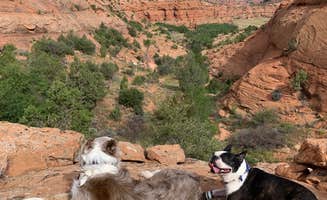Dispersed camping options abound within a 25-mile radius of Kayenta, Arizona, where the high desert climate features dramatic temperature swings between day and night. Summer temperatures regularly exceed 100°F while winter nights can drop below freezing. The sandy terrain throughout the Monument Valley region requires specific preparation for tent stakes and vehicle traction, particularly after rare but intense rainfall.
What to do
Early morning hikes: Trails near The View Campground provide access to spectacular sunrise vantage points. "We took the site that had trees for shade. Each site had a picnic table and fire pit. The campground has a cute history and fun touristy things to check out... and it's convenience to Monument Valley is superb," notes Stacie H. The Wildcat Trail loop allows for independent exploration without a guide.
Navajo cultural experiences: Try traditional cuisine offered by camp hosts. "We ordered a local meal from the owner and we enjoyed it! I highly recommend," shares Rodolphe R. from Hummingbird Campground. Some campgrounds offer Navajo Tacos prepared by hosts for around $18 per plate, providing authentic cultural connections.
Stargazing: Take advantage of minimal light pollution. "Once the moon set that night, the stars were amazing on a beautiful clear desert night," explains Brian P. who stayed at Valley of the Gods. The region's elevation and dry air create exceptional night sky viewing conditions throughout the year.
What campers like
Privacy options: Sites with varied spacing accommodate different preferences. "Located just a few miles north of Monument Valley, you'll be surrounded by lesser known monuments in this campground, including Sleeping Bear, where the campground gets its name," writes Katie M. about Sleeping Bear Campground. Many campers appreciate the balance between solitude and safety.
Access to photography spots: Multiple campgrounds position visitors for optimal landscape shots. "The sites are set up in a semi circle. Each has an excellent view of a handful of the distant mittens," John A. notes about Arrowhead Campground. This arrangement allows photographers to capture unique angles without crowds.
Historic connections: Several sites feature educational displays about area history. "Take the time to visit the local museum. Fun to learn about the films made here. We've camped here several times, but never hang out at the campground. We mainly use it as a jumping point to explore all the other things this area has to offer," shares Debi R. The region's connection to classic Western films adds cultural interest beyond natural scenery.
What you should know
Varying shower availability: Facilities range from modern to primitive. "The bathrooms are very clean, they're practically brand new. We watched the most beautiful sunset over the landscape," explains Kayla M. about Monument Valley KOA. Some locations require codes for shower access while others operate on first-come systems.
Seasonal considerations: Spring and fall offer most comfortable temperatures. "We visited Memorial Day Weekend. The campground was empty because it was HOT. The campground is a basic dirt field with only a few small trees," reports Stacie H. Summer camping requires significant water supplies and heat management strategies.
Navajo Nation regulations: Special permits required for some activities. "We did a tour that included a dinner and Indian ceremony. It was an incredible experience!" shares Debi R. Guided tours provide access to restricted areas not available to independent travelers.
Tips for camping with families
Sheltered sites: Choose locations with natural windbreaks. "This site is super easy to find, has wonderful views, super clean pit toilets, and great for the price point," notes Amanda M. about Sleeping Bear Campground. The frequent strong winds can make tent camping challenging without proper site selection.
Water conservation strategies: Limited supplies require planning. "You need to bring all that in. The closest town is Mexican Hat to the south and Bluff to the north," advises Jeff H. Most campgrounds lack potable water sources, requiring families to bring 1-2 gallons per person per day.
Safety boundaries: Cliff edges require supervision. "Small utah state park. Sites are on barren ledge above the goosenecks. No water and wind could be an issue here for tents primarily," notes Greg L. about Goosenecks State Park Campground. Unfenced overlooks demand constant awareness with children.
Tips from RVers
Road surface preparation: Many access roads feature loose sand or rock. "The road is in great shape. The scenery is truly out of this world. Plenty of places to camp off Valley of the Gods Rd," shares Brian M. RVs should carry traction devices and maintain low tire pressure on unpaved routes.
Site leveling challenges: Most areas feature natural, ungraded terrain. "Dirt pads but fairly level. I was in a 33ft toy hauler and had no problems with the dirt road and room to pull thru," reports Jennifer R. about Sleeping Bear Campground. Bringing extra leveling blocks helps manage the uneven surfaces common throughout the region.
Generator considerations: Some sites restrict hours or prohibit use entirely. "This KOA is a low light campground, so a star filled night sky not tainted with mercury vapor lights," notes Cynthia K. Campers requiring continuous power should select sites with hookups or prepare alternative power sources.









